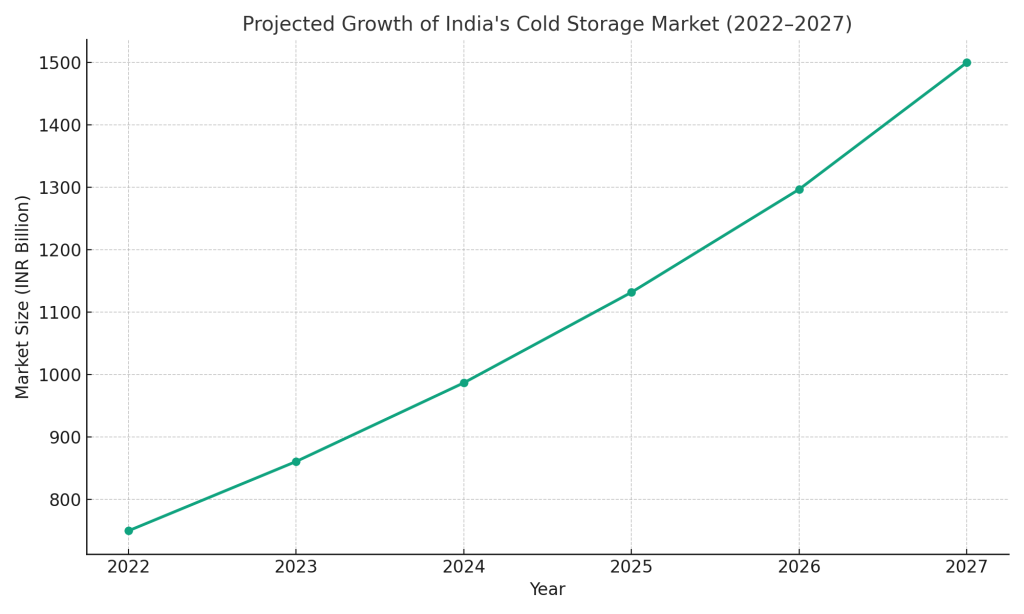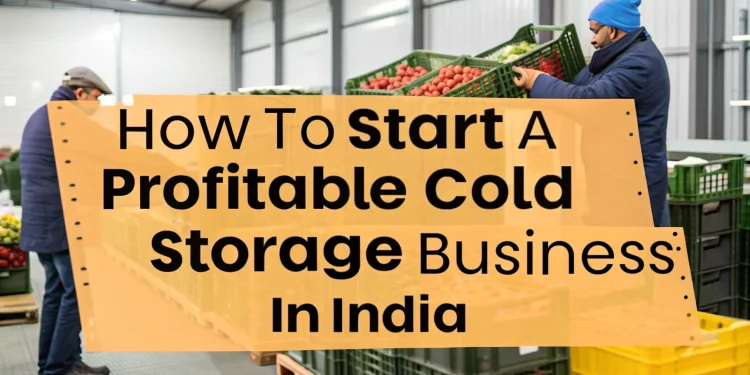The agriculture, pharmaceutical, seafood, and e-commerce sectors in India require a well-planned cold supply chain. This is true in the context of the ever-evolving cold storage landscape in India. There is a possibility of unlocking high-value profit margins by having a cold storage facility. In India, investing in a cold storage Business facility means relieving the market of an understaffed and fast-growing industry.
In this guide, we will discuss the operational requirements, industry growth, profitability, and strategic considerations, all of which revolve around the successful construction of a cold storage business.
Why Cold Storage Matters Today
The construction of cold storage in India aids in food preservation, storage, enhances food export, and curbs food loss. India is known for its wide variety of farming, including fruits, vegetables, seafood, and the pharmaceutical industry. However, it lacks a proper cold chain infrastructure. This means crying a higher risk of food spoilage.
The cold storage business has expanded its scope and now includes IoT technology, energy efficiency, last-mile delivery systems, and advanced tech integration. From pharma-grade freezers in metro areas to temperature-controlled milk chillers in rural towns, the industry is transforming.
Related: How to Start a Profitable Cold Storage Business
Key Functional Components Of Cold Storage Facilities
The cold storage facility’s two core components are temperature management and refrigeration systems. The refrigeration components are critical in ensuring product integrity in the following industries:
- Agriculture and Dairy: Storage of milk and dairy products, as well as perishables like butter, and value-added products such as cheese.
- Seafood and Meat: Helps maintain international quality and extend the shelf life of seafood and meat exports.
- Pharmaceuticals: Helps store vaccines, biologics, and APIs at stringently controlled temperatures.
- E-commerce and Q-commerce: Support the frozen and fresh items for same-day delivery.
Advanced cold storage facilities also have IoT-based temperature, humidity, and energy usage tracking systems alongside automating inventory and safety protocols.
Different Types Of Cold Storage Models
The various types of customers and target sectors for cold storage businesses create several different cold storage business models.
- Private Cold Storage
This is built and owned by businesses such as food and pharmaceutical companies, dairy, and food processing companies. These are built to serve the company’s supply chain needs and tend to be closed systems with steady inventory flow. - Public or Third-Party Cold Warehouses
These businesses serve as B2B service providers, renting space to traders, exporters, manufacturers, or wholesalers. Such facilities offer storage options across multiple sectors and can serve multiple clients. - Flexible Cold Storage (Hybrid)
These are the most recent units and are separated into multiple chambers with different temperature zones, allowing for the storage of mixed products. These flexible cold storage offer both B2B and B2C business models and are beneficial in urban areas for last-mile delivery logistics.
Market Growth and Investment Potential
India stands as one of the strongest countries in the world, with the ability to produce more than 300 million metric tons of perishable goods. This puts India in the position of having great market possibilities, as there still lies great work to be done for the cold chain post-harvest.
The cold storage market in India is expected to achieve ₹1,500 billion by 2027. This places the growth of the storage market at 14.8% for the years 2022-2027. This growth is sparked by the following reasons:
- Government spending on agri-logistics and food processing infrastructure.
- Increased need for temperature-sensitive pharmaceuticals and vaccines.
- Increased spending for Q-commerce and grocery delivery services.
- Increased spending on frozen seafood, exotic fruits, and biologics by other countries.
- Decreased climate stability and increased food prices.

Related: Cold Chain Temperature Controlled Supply Chain
Demand and Applications by Sector
Agriculture and Dairy
India is the top producer of milk and the second-largest producer of fruits and vegetables in the world. Cold storage helps in avoiding spoilage and helps in stabilizes prices during the harvest season. Refrigerated storage and milk chilling units are especially important in this sector.
Meat and Seafood Export
Sectors like shrimp and buffalo meat are highly export-oriented and require a maintained cold chain for international compliance. Cold storage is a necessity as the blame for a lot of shipment rejection rates are owing to storage failures.
Pharmaceuticals
Vaccines, insulin, and high-value APIs require strict storage under 2 to 8 degrees Celsius for monitoring. These units require cold rooms that are WHO-GMP certified for compliance and surveillance-grade certified monitoring. 24/7 power backup and real-time tracking is a must for regulated compliance.
E Commerce and Hyperlocal Delivery
There is a growing urban demand for hyperlocal and cold chain-integrated storage as online platforms are scaling their operations. It has become commonplace for cold storages facilities to have prep-zones and cross-docking zones for last-mile delivery improvement.
Steps to Build a Cold Storage Business
Sequentially Selecting the Location
The best location should have a good balance between the sourcing of raw materials and transport systems. Some important considerations are:
- proximity to farms, ports, food processors, and pharma parks.
- Access to major roads, rail, and ports.
- Stable supply of power and water.
- Presence of trained and certified technical staff.
Facility Design
Cold storage facilities make use of PUF (Polyurethane Foam) insulated panels for cold storage construction to help maintain internal temperatures and reduce energy costs. Pre-engineered buildings (PEBs) provide accelerated construction timelines, scalability, and increased durability.
View our handbooks on Cold Storage
Refrigeration Systems
Operators can choose between ammonia and Freon-based systems due to their differing scales and product requirements. Temperature ranges from +20°C to -40°C need to be maintained with various equipment such as compressors, evaporators, condensers, as well as humidity control systems.
These modern systems also integrate:
- IoT for temperature and energy monitoring.
- Automated SCADA systems with fault alert capabilities.
- Backup or solar systems for power continuity.
- Inventory control with RFID or barcode systems.
Operations and Staff
Trained staff guarantees smooth operations, managing:
- Inventory control, including rotation and shelf-life monitoring.
- Hygiene and sanitization protocols.
- Scheduled maintenance of refrigeration equipment.
Cold storage facility types by application
| Type | Usage Example |
| Single-Commodity Storage | for apples and dairy keeps them at 2°C to 6°C. |
| Multi-Commodity Storage | for fruits, vegetables, meat, and seafood requires multiple chambers. |
| Controlled Atmosphere (CA) | for apples and pears requires O2, CO2, and N2 control, maintained at 0°C to 4°C. |
| Pharma Cold Rooms | for vaccines, blood samples, and APIs require 2°C to 8°C or subzero temperature with surveillance. |
Strategic Positions for a Cold Storage Investment
Strategic Location Choices for Cold Storage Investment
These directly influence profitability alongside market proximity.
- Nashik (grapes), Lucknow (potatoes), Ludhiana (milk), and Kolkata (fish) are agriculture-based hubs with strong procurement capabilities and consistent demand throughout the year.
- Chennai, Kochi, and Visakhapatnam are good coastal locations for cold storages facilities that are focused on exporting seafood.
- E-commerce cold chain logistics are on the rise in urban centers like Delhi, Mumbai, and Bengaluru.
- Food parks and Special Economic Zones (SEZs) provide facilities under the PM Kisan SAMPADA Yojana that grant capital subsidies, lower taxes, quick approvals, and other benefits.
Cold Storage Regulatory Overview
In India, cold storage and other food preservation facilities require multiple approvals, including:
- FSSAI Registration: Required for food-grade cold storage facilities.
- Drug Control Licensing: Mandates cold rooms for pharmaceuticals.
- Pollution Control and Fire Safety Permits: Varies by refrigerant type and facility size.
- Building and Electrical Systems Permits: Must meet applicable safety standards.
- Labor Safety and Business Insurance: Protect the employer and the insured.
Regular energy audits and hygienic certifications, on the other hand, build credibility with institutional clients and exporters.
For more information, check out this video
NPCS Cold Storage Business Assistance
In the case of cold storage business units, strategic, operational, and financial aspects of the business must be clear from the start. NPCS provides comprehensive guidance with Market Survey cum Techno-Economic Feasibility Reports.
NPCS’s service offerings include:
- Complete project-specific layout with process design.
- Equipment and raw material procurement.
- Legal, regulatory, and operational feasibility scope.
- Industry-specific tailored market entry strategies.
NPCS reports are highly valued by entrepreneurs, investors, banks, and government agencies for assessing and financing cold chain infrastructure projects.
Find the Best Idea for Yourself With Our Startup Selector Tool
Conclusion: Why Cold Storage is a Resilient, Profitable Business
Cold storage is no longer an optional investment; it is essential for reducing national food loss, meeting global export standards, and safeguarding temperature-sensitive pharmaceuticals. Its multi-sector relevance makes it a recession-proof and impact-driven business.
Entrepreneurs who invest in energy-efficient infrastructure, technology integration, and client-focused models will gain access to recurring income, asset appreciation, and strong ROI. Moreover, they’ll play a pivotal role in building India’s next-generation supply chain.
If you’re planning to enter the cold storage industry, this is the right time. Begin by leveraging expert guidance from NPCS and build a business that’s profitable, future-ready, and socially impactful.


















